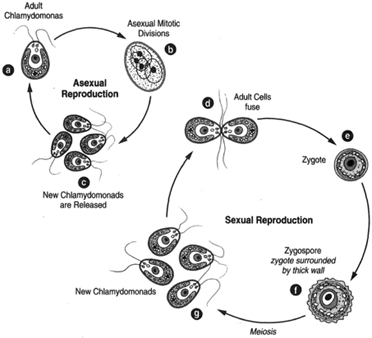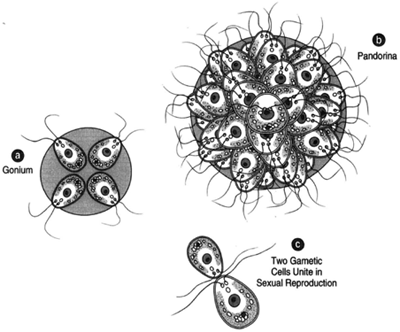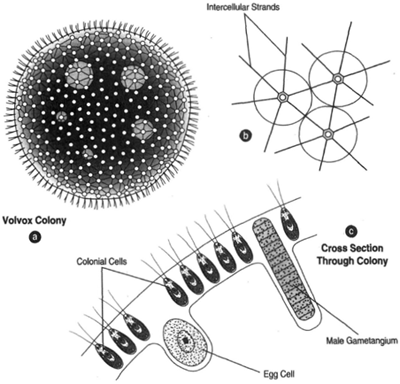The Volvacine Line
ChlamydomonasChlamydomonas represents an ancient algal form. Chlamydomonas-type cells appear in the fossil record tracing back 1 billion years.
Chlamydomonas is a minute (approximately ten-thousandth of an inch long), single-celled, flagellated green alga. It is a round or pear shaped and possesses a rigid cellulose cell wall, contractile vacuoles, a cup-shaped chloroplast, and a pair of whiplash flagella at the anterior end. The flagella pass through tiny holes in the cell wall. Each, of course, has a cell membrane immediately inside the cell wall. Chlamydomonas also each have a red-pigmented eye spot, or stigma, considered to be light sensitive, and a pyrenoid body that functions as a center for the formation of starch. The starch eventually changes into an oil. Although pyrenoids are widely distributed in algae, they do not occur in most land plants. While Chlamydomonas are green, photosynthetic cells, they may get some of their nutrients readymade from the surrounding water. The word chlamys is Greek for “cloak”. The name Chlamydomonas derives from the fact that the chloroplast appears to form a cloak around the nucleus.
 |
| Figure 13-2 (a) Chlamydomonas. The name derives from the chloroplast forming a cloak around the nucleus(.b ) Asexual reproduction: mitotic divisions within the cell wall. (c) New Chlamydomonads are released. (d) Sexual reproductcioenll:s fuse in pairs to form zygotes, (e) and ( f), which can then undergo meiosisto produce new Chlamydomonas cells, (g). |
Reproduction in Chlamydomonas is both asexual and sexual. In asexual reproduction, the cell undergoes mitotic divisions within the cell wall. There may be as few as two divisions or as many as four. The daughter cells are at first contained within the parent cell wall; after a short time, however, the wall breaks down, and the miniature Chlamydomonads escape and grow to full size.
A change of environmental conditions sets the stage for the sexual process. Again, the protoplast divides a number of times by mitosis, producing a number of cells within the cell wall. When the cell wall breaks down, these small cells escape, come together, and fuse in pairs. Because the gametic cells that fuse are alike in size and shape, this is called isogamous fusion. The cells come in contact at their flagellar ends and fuse to create a diploid zygote, which at first has four flagella. The flagella then fall off, and a hardened outer covering is produced. This results in the formation of a zygospore able to survive adverse conditions. When living conditions again become favorable, the zygospore undergoes meiosis to produce four haploid zoospores. These mature into the new Chlamydomonads. Note that the only diploid cell in this life cycle is the zygospore.
In some situations, the gametes that fuse to form the zygospore come from the same cell. This is called homothallic sexual reproduction. In certain species of Chlamydomonas, this cannot take place. Rather, fusion requires the production of isogametes from mating types of cells. Such cells and gametes are designated plus (+) or minus (−), and plus and minus gametes must come together. This is called heterothallic sexual reproduction.
Gonium, Pandorina, Pleodorina, and Volvox
In examining figure 13-1 note that leading upward toward the left is a series of algae of increasing numbers of cells. The first in the series has four cells and is called Gonium pectorale. The next form, Pandorina morum, can have sixteen or thirty-two cells. In both of these the cells are like Chlamydomonas in being flagellated and in other characteristics. The essential difference seems to be that the cells are stuck together and embedded in a matrix, rather than occurring individually. Pleodorina (or Eudorina) is another colonial form of alga. It differs from the others primarily in the number of cells in the colony, there being as many as 128. Volvox is the most complex of the several colonial forms; most of the cells, however, are Chlamydomonas-like. The colonial forms thus far mentioned are collectively called the Volvacine line.
In Gonium and Pandorina, there is no interdependence among the cells. Each cell is an individual, and the cells occur together only because of the matrix. A coordination of flagella activity, however, does develop. In Eudorina, the ball of cells becomes hollow in the center, and a polarity develops; one end of the colony points forward as the colony swims. This coordination seems to be made possible by the formation of delicate protoplasm strands that interconnect the cells.
Both asexual and sexual forms of reproduction occur in the Volvacine line. In Gonium, each cell can divide to form a new colony. Because the cells have walls, the divisions that form the new colonies take place within the & Notes & original cell wall. Only after the new colony has formed does the wall break down and allow release. After the breakdown of the parent cell wall, no further divisions occur. The new colonyth at forms within the parent wall is called a coenobium. A coenobium can be defined as a colony of unicellular
 |
| Flgure 13-3 The Vohracine line: (a) Gonium and (b) Pandoha. Anisogamous sexual reproduction may occur. (c) Two gametic cells unite. The zygote is the only diploid cell. When the zygote germinates, meiosis occurs, produczionogs pores that grow into new colonies. |
organisms surrounded by a common wall.
Asexual reproduction in Pandorina is somewhat different. The cells divide internally to produce mospores, which then break out of the parent “box” all at the same time (thus the term Pandora’s box). The zoospores then divide to form new colonies. Sexual reproduction in Pandorina is very similar to that described for Chlamydomonas except that the gametes that come together differ in size. This is referredt o as anisogamous sexual reproduction (seef igure 13-3). Two types of gametes are produced: larger and smaller. When fusion occurs, only larger and smaller gametes come together. The resulting zygote, then, is diploid, and is the only cell in the life cycle that has the doubled chromosome number. Cell divisions of the zygote are meiotic and result in the formation of zoospores.
Volvox marks the high point in the evolution of the Volvacine line. The number of cells in the colony can range from 20,000 to as many as 50,000. Each cell in the colony is Chlamydomonas-like. A cell in the colony may enlarge, break away internally from The surface of the sphere, undergo mitotic divisions, and form a new colony. Several of these may be seen in the hollow center of the mother colony, where an amazing event occurs. When first formed, the minute colonies all have their flagella directed inward toward the center of the hollow ball, which contains a hole. Then, all at the same time, the entire colony turns itself inside out so that the flagella are on the outside of the sphere.
 |
| Figure 13-4 Volvox: (a) a colony of many cells; (b) an enlargement of the cells showing intercellular strands and surrounding matrix; (c) colony portion showing an individual colonial cell, an egg cell, and male gametangium. |
Sexual Reproduction in Volvox involves clearly differentiated gametes; sperm and egg. This condition is called oogamy. In some species of Volvox, both sperm and eggs are found in the same colony and are thus referred to as monoecious (literally, "living in one house"). In other species, the colonies are either male or female; sperm cells are formed in one colony, egg cells in another. This condition is referred to as dioecious (literally, "living in two house"). It is tempting to infer that such differentiation into seperate sexes accounts for this condition in subsequent evolutionary history. The fact that Volvox appears to be a dead end in evolution contradicts this interference, however. The differentiation of sexes as we know it in the modern world apparently took another route.




